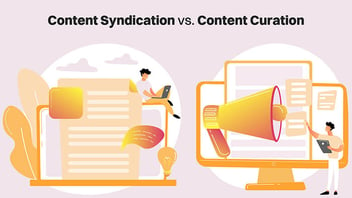
10 Ways To Generate Leads For Your Manufacturing Companies
Are you a marketing professional, SDR, or BDR looking to enhance lead generation for your B2B manufacturing company?
As a marketing pro, your expertise lies in attracting and nurturing leads. On the other hand, SDRs/BDRs play a vital role in filling the sales pipeline with qualified prospects.
A steady stream of manufacturing high-quality leads is crucial for the success of your sales team. Without it, the revenue potential remains untapped, and the sales process becomes an uphill battle.
Every day that passes without a fresh influx of quality leads is a missed opportunity for your business. Hence, you need an effective solution to attract and engage potential customers consistently.
But where should you begin?
Don't worry, help is at hand. This blog post explores 10 actionable steps to turbocharge your manufacturing business's lead generation efforts. So, let’s get started.
How Can You Generate Leads for Your Manufacturing Business: 10-Step Guide
To help you grasp the intricacies of lead generation and provide a comprehensive understanding, we have segmented our lead generation strategy into three main categories:
1. Lead Identification
2. Lead Engagement
3. Lead Nurturing
Each category is crucial in guiding potential leads through the sales funnel and nurturing them into loyal customers.
Let's take a closer look at each category and explore how they generate sales-ready leads:
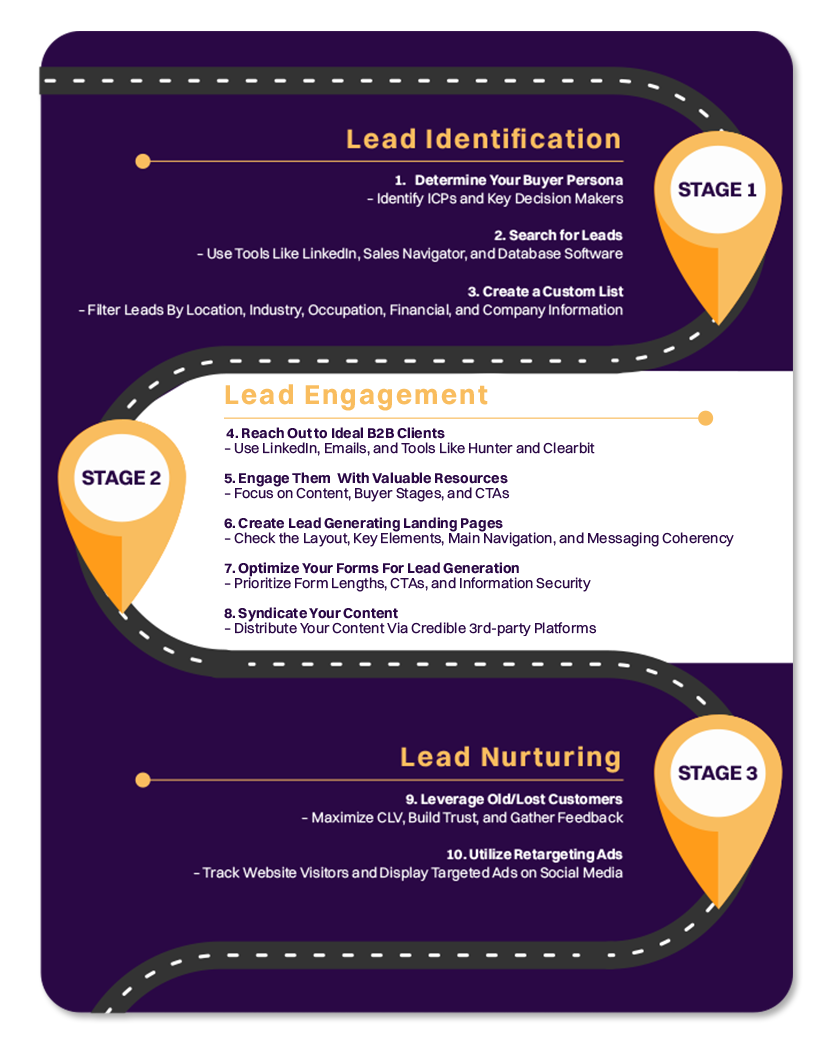
A. Lead Identification
Lead identification pinpoints potential prospects or individuals interested in your products or services. It’s often done via various marketing and lead generation strategies. Here’s how you can identify leads in the manufacturing industry:
1. Determine Your Buyer Persona
To kickstart your lead generation efforts, identify your buyer persona. It’s the initial and essential step in understanding the companies you're targeting with your services.
Think of the buyer persona as a fictional character who embodies the characteristics of the person within the target company you aim to sell to.
Research and delve into the demographics of your ideal buyer. As such, you can effectively showcase the value your manufacturing business brings to the table.
Take a look at the industries you're targeting, such as:
- Oil and fuel
- Utilities
- Healthcare
- Automotives
- Contractors and more
For example, let’s say your manufacturing specialization revolves around industrial lighting. Then what will your primary clients consist of? Construction firms or operators of industrial plants, etc., right?
Next, it's time to dive deeper into the individuals running these establishments and gain insights into their preferences.
Consider factors like age, gender, and primary motivations for purchasing from your manufacturing business. Plus, study the pain points they seek to address.
Understanding these aspects will help you create a clearer image of your ideal buyer – enabling you to select the most valuable leads for your business.
- Identify ICPs and Decision Makers
Understand your target customers and who holds the decision-making power within their organizations. As such, you can streamline your outreach efforts and increase your chances of closing successful deals.
Let's start by exploring the concept of Ideal Client Profiles – ICPs. These profiles represent the characteristics and attributes of your ideal customers.
Analyzing data and conducting market research enable you to identify common traits shared by your most valuable customers in the manufacturing industry.
This includes factors such as:
- Industry verticals
- Company size
- Geographic location
- Specific needs
- Pain points
Developing an ICP helps you focus your marketing and sales efforts on attracting prospects who align closely with your ideal customer characteristics.
Here's an example of how an ICP table might look like for the manufacturing industry:
| Industry Vertical | Company Size | Geographic Location | Specific Needs |
| Automotive | Large | United States | Efficient Supply Chain Solutions |
| Electronics | Medium | Europe | Advanced Quality Control Systems |
| Aerospace | Small | Asia | Customized Component Manufacturing |
Now, let’s move on to decision-makers. You must identify the right stakeholders within target organizations. These individuals have the authority to make purchasing decisions. Hence, they can significantly impact the outcome of your sales efforts.
Connecting with the right decision-makers increases your chances of engaging in meaningful one-on-one interactions that can lead to successful deals.
Knowing which stakeholders to target depends on the specific industry and company you are dealing with. Some examples of decision-makers you may encounter in the manufacturing industry include:
- Engineers
- Managers
- Technicians
- Directors and others
However, decision-making structures differ from company to company, presenting a challenge in reaching the right people. But fear not, for Revnew is here to lend a hand. Our seasoned team excels in forging connections with key decision-makers, igniting conversions, and amplifying your sales opportunities.
To support our claims, check out the outcomes of Revnew’s partnership with USS VISION. This case study features a prominent custom equipment manufacturer – that collaborated with Revnew to attract and convert relevant prospects, propelling their business to new heights.
2. Search for Leads
Searching for leads is the second fundamental step in any effective lead generation strategy. By proactively seeking out potential customers, you can identify and connect with individuals and companies that align with your target market.
Here are three valuable methods to search for leads:
- Leads Via LinkedIn
LinkedIn is a powerful B2B lead generation platform. Its extensive network of professionals and businesses offers a wealth of opportunities to find and engage with potential leads.
Use LinkedIn's advanced search filters to narrow your search based on criteria such as industry, job title, location, and company size. It allows you to target individuals who match your ideal customer profile.
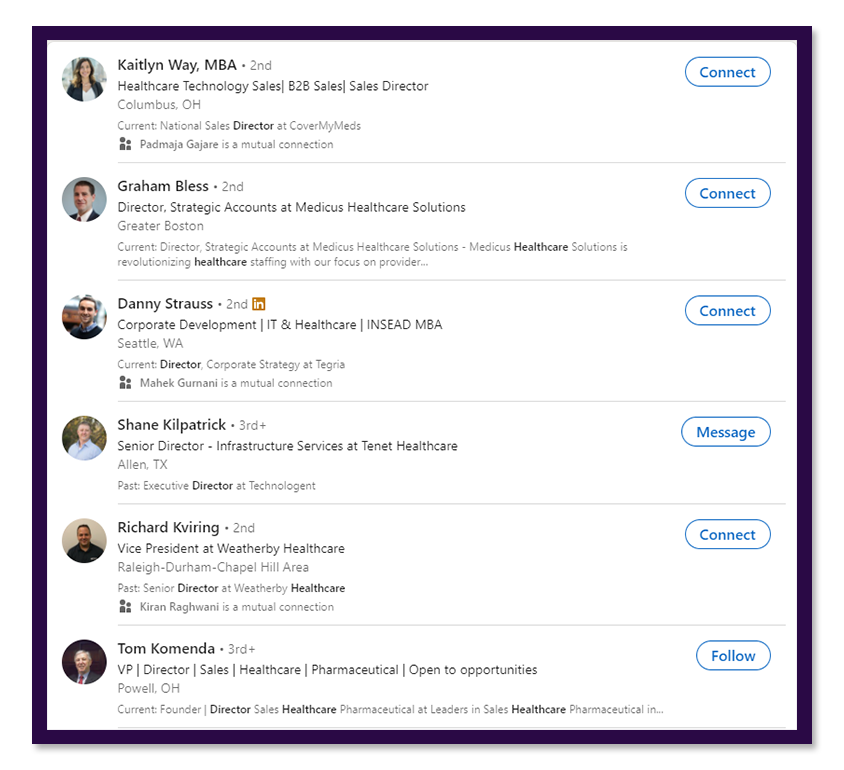
Use LinkedIn's messaging feature to reach out and start meaningful conversations with potential leads.
- Leads Via Sales Navigator
LinkedIn Sales Navigator is a premium tool designed explicitly for lead generation and sales professionals. It provides enhanced search capabilities, advanced filters, and features to help you identify and track leads effectively.
With Sales Navigator, you can save leads, receive personalized recommendations, and gain insights into their professional activities and connections. This information allows you to approach leads more targeted and personalized, increasing your chances of success.
- Leads Via Database Software
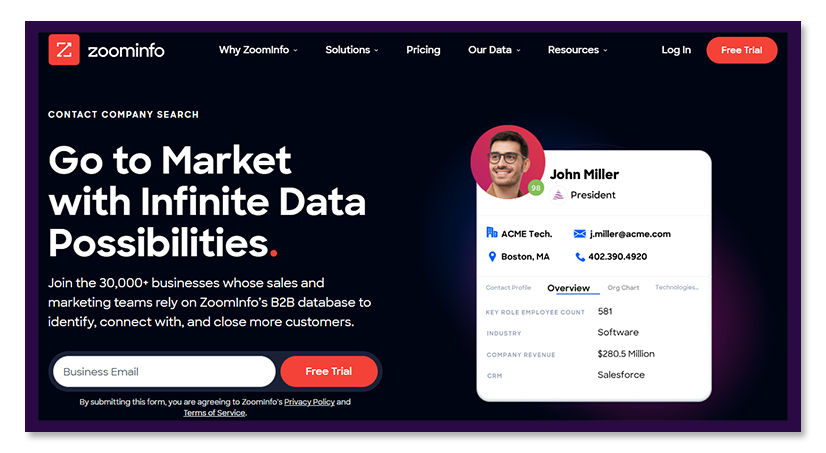
Database software such as Zoominfo provides access to a vast repository of company and contact information, making it a valuable resource for lead generation. These platforms compile data from various sources, including:
- Business directories
- Social media profiles
- Public records
Use the search functionality to filter leads based on specific criteria such as industry, location, company size, and job titles. It enables you to build targeted lists of potential leads and gather valuable contact information to initiate outreach efforts.
3. Create a Custom List
After gaining a deeper understanding of your target audience, compile a custom list of leads that align with your ideal buyer persona. This process involves the following steps
- Step 1: Select the relevant activity sectors and industries you target.
For instance, if your manufacturing business specializes in metals and machinery, you would choose that category as a starting point.
You can also select multiple industries to broaden your pool of potential leads, ensuring a more targeted approach.
- Step 2: Next, consider the locations that you serve. It lets you focus on local businesses if you intend to attract companies in your immediate area.
However, if your products are shipped worldwide, you can research multiple countries to expand your reach and target businesses globally.
- Step 3: To refine your custom list further, consider your target clients' specific occupations within their respective companies.
It helps you narrow your search and identify the key decision-makers/influencers crucial in purchasing.
- Step 4: Additionally, consider the financial and company information. These can provide valuable insights into the prospects' financial stability and overall fit with your business objectives.
Once you have completed this process, you will have a list of prospects that meets your specific criteria. Organize the leads according to relevance, with the most promising prospects at the top.
It allows you to prioritize your outreach efforts and focus on contacting the individuals who closely match your ideal buyer persona.
To illustrate this process, let's consider a hypothetical example:
| Activity Sector | Industry | Location | Occupation | Financial Information | Company Information |
| Manufacturing | Metals | United States | Procurement Manager | High revenue growth | Established market presence |
| Manufacturing | Machinery | Canada | Engineering Director | Stable financial performance | Innovator in the industry |
Now that you have pinpointed your leads, you should invest time and resources in engaging them. Let’s check out how.
B. Lead Engagement
Lead engagement is the act of interacting and nurturing leads through personalized communication. It involves providing valuable resources and guiding them through the buyer's journey to build trust and increase the likelihood of conversion.
Here’s how you can engage leads in the manufacturing domain:
4. Reach Out to Ideal B2B Clients
You can contact your prospective clients via multiple channels. Here are the major ones:
One of the primary channels for reaching out to potential clients is LinkedIn. Start by sending them a personalized connection request on LinkedIn with a well-crafted message.
In your message, highlight the value proposition of your manufacturing business. Also, demonstrate how your products or services can address their needs and challenges.
Here’s a sample LinkedIn message:
“Hi [Prospect's Name],
I hope you're doing well. I wanted to connect with you on LinkedIn and introduce [Your Manufacturing Business]. We deliver high-quality manufacturing solutions tailored to your unique needs and challenges. Let's explore how we can contribute to your success.
Looking forward to connecting!
[Your Name]
[Your Manufacturing Business]”
NOTE: Personalization is key here. It shows you have taken the time to understand their requirements and tailor your approach accordingly.
- Emails
Besides LinkedIn, email marketing is another valuable tool for engaging with B2B clients. Craft compelling, personalized email campaigns that capture their attention and provide relevant information about your manufacturing offerings.
Focus on addressing their pain points and showcasing the benefits they can gain from partnering with your business.
Here’s a sample email template:
“Subject: Streamlining Healthcare Manufacturing – Let's Connect
Dear [Director's Name],
I hope you're doing well. As the Sales Manager at [Your Manufacturing Company's Name], I wanted to discuss a potential partnership to address pain points within your healthcare organization.
We specialize in delivering innovative manufacturing solutions tailored for the healthcare sector. By partnering with us, you can benefit from:
- Enhanced Efficiency: Our advanced technologies and streamlined processes optimize production cycles, reducing time-to-market and minimizing waste.
- Superior Quality Control: Our rigorous quality assurance system ensures compliance with industry regulations and delivers products of the highest standards.
- Cost Optimization: Our expertise in lean manufacturing identifies areas for cost reduction without compromising product integrity, achieving greater financial efficiency.
- Scalability and Flexibility: Our manufacturing capabilities can adapt to your evolving needs, meeting market demands and accommodating custom requirements.
I'd love to discuss how we can tailor our solutions to your specific pain points and help your organization thrive. Could we schedule a brief call? Please let me know your availability for next week, and I'll promptly arrange it.
Thank you for considering [Your Manufacturing Company's Name]. Let's streamline your healthcare manufacturing processes together.
Warm regards,
[Your Name]
Sales Manager
[Your Manufacturing Company's Name]
[Contact Information]”
- Tools
To ensure accurate contact information for your outreach, you can utilize various tools such as Hunter and Clearbit.
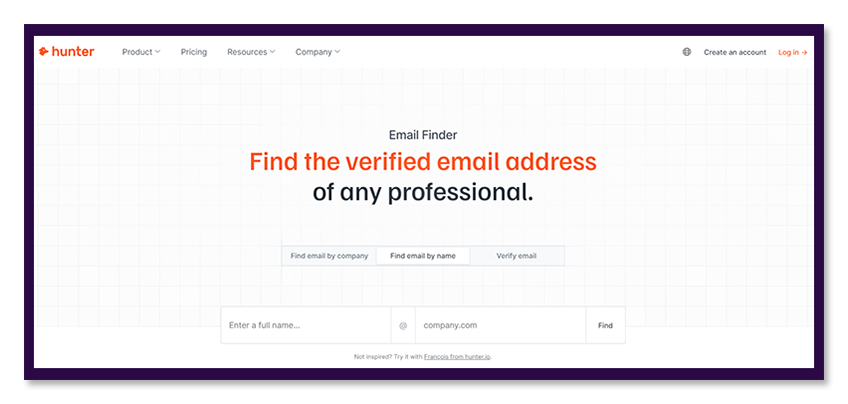
These tools enable you to find your targeted clients’ phone numbers and email addresses. By leveraging these resources, you can ensure your outreach efforts are directed to the right individuals – enhancing the chances of successful engagement.
Remember: When reaching out to ideal B2B clients, approach them with a value-focused mindset. Hence, clearly communicate the unique value proposition of your manufacturing business and how it can positively impact their operations.
5. Engage Them With Valuable Resources
Engaging your leads with valuable resources is critical to lead nurturing. By providing relevant and compelling content, you can establish credibility, build trust, and position your manufacturing business as an industry authority.
Here’s an example of how you can create a repertoire of valuable resources to address buyers' pain points in the defense industry:
| Pain Points/Concerns | Solutions/Resources |
| Accurate data |
|
| Complete quotes |
|
| Counterfeit parts |
|
| Complex defense projects |
|
Here are some effective strategies to engage your leads with valuable resources:
- Create Engaging Content Offers
Craft content offers that are informative and appeal to your leads' interests and motivations. Here’s how:
- Incorporate psychological tactics such as scarcity, leveraging the idea that the offer is limited or time-sensitive to create a sense of urgency.
- Additionally, utilize the bandwagon effect by highlighting the popularity or success of your content offer. It emphasizes that others in the industry are benefiting from it.
- Another approach is newsjacking. It involves leveraging current industry news or trends to make your content timely and relevant.
- Focus on Different Buyer Stages
Tailor your content offers to align with the different stages of the buyer's journey, such as:
- Awareness Stage: Provide educational content that addresses readers’ pain points and introduces them to potential solutions.
- Consideration Stage: Offer more in-depth content, such as case studies or product comparisons, that help prospects evaluate different options.
- Decision Stage: Provide content showcasing the unique value and benefits of choosing your manufacturing business.
Here’s an illustration of content resources for the three stages:
| Buyer Stage | Content Offer |
| Awareness |
|
| Webinar: "Introduction to Lean Manufacturing Principles" | |
| Consideration |
|
| Industry Report: "Market Trends and Forecast for the Manufacturing Sector" | |
| Decision |
|
- Utilize Persuasive CTA Language
When promoting your content offers, use persuasive CTA language, encouraging leads to take the desired action. Use action verbs and emphasize the benefits or value they will receive by accessing the content.
For example, instead of a generic "Download Now" CTA, try "Get Exclusive Access to Industry Insights" or "Unlock Expert Strategies for Manufacturing Success."
6. Create Lead Generating Landing Pages
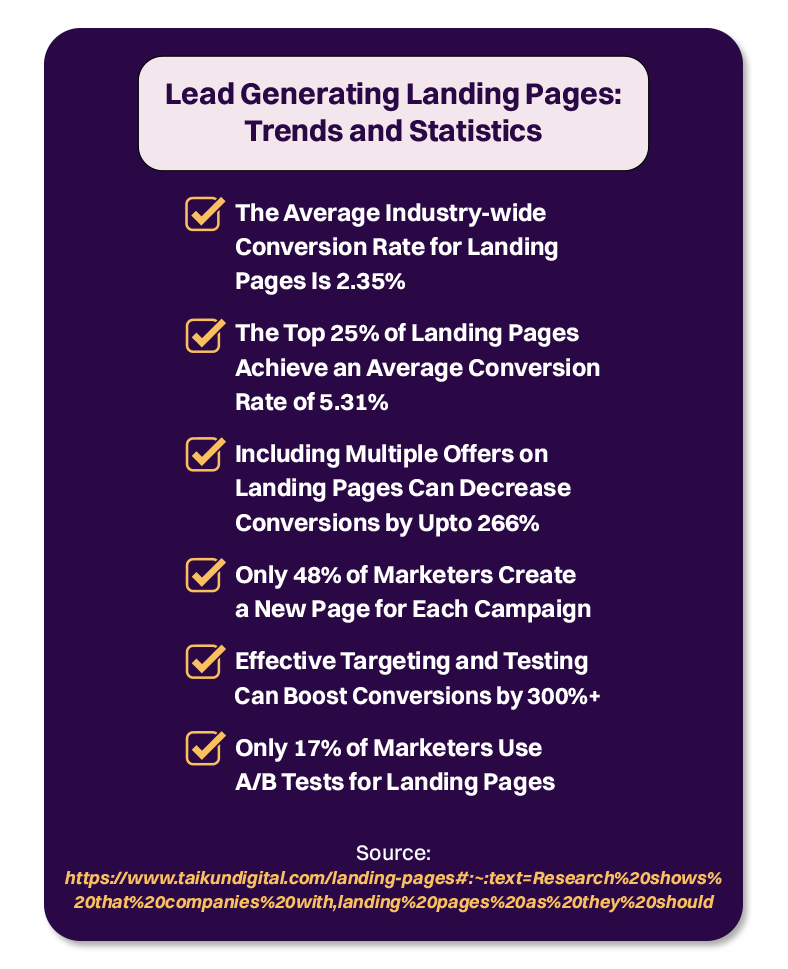
Creating lead-generating landing pages is crucial for capturing valuable leads in the manufacturing industry. When visitors click on a CTA, they are directed to a landing page specifically designed to convert them into leads.
Here are some key points to understand about creating effective landing pages for lead generation:
- Check the Layout: Design your landing pages to capture lead information by providing a seamless user experience. Keep them free from distractions, such as visible navigational panels.
Plus, encourage visitors to offer their basic contact information in exchange for your appealing offer.
- Focus on Key Elements: A well-designed landing page consists of the following critical components:
- A compelling headline and sub-headline
- A brief description of the offer
- At least one supporting image
- A form to capture the industrial lead's information
Include all these elements to help engage visitors and encourage them to take action.
- Ditch the Main Navigation: Removing the main navigation from the landing page is essential to increase conversion rates. It helps keep visitors focused and prevents distractions that might lead them away from converting to the page.
- Maintain Messaging Coherency: Consistency in messaging is crucial for building trust and avoiding confusion. Ensure the messaging on the CTA matches the landing page's headline.
Any discrepancies between the two may cause visitors to lose trust and question the offer's legitimacy.
- Do Away With Clutter: Keep the design of your landing page simple and uncluttered. Too much information or visual clutter can distract visitors and reduce their conversion chances. Be concise and to the point, providing necessary details in the offer itself.
- Showcase Offer Benefits: Clearly communicate the value and benefits of the offer on your landing page. Use a brief paragraph and/or bullet points to explain how the offer can benefit the prospect. Focus on the outcomes and advantages rather than simply listing the features.
- Promote Social Sharing: Include social sharing buttons on your landing page to encourage prospects to share your content and offers with others.
By enabling easy sharing on various social media channels and email, you can increase the reach of your landing page and attract more leads.
- Embrace Dark Social: Add sharing buttons on your landing page for easy sharing via private channels like messaging apps and email.
Harness the power of dark social to tap into hidden sharing activities, amplify your message, and gain valuable insights into your audience's preferences.
Finally, increase the number of landing pages. It can significantly impact lead generation. In fact, according to a marketing benchmarks report, companies that go from having 10 landing pages to 15 experience a 55% increase in leads.
Key Takeaway: Creating more content, offers, and landing pages expands your opportunities to capture leads and drive business growth.
7. Optimize Your Forms For Lead Generation
Forms significantly capture visitors' information on landing pages. Consider the following points to optimize your forms effectively:
- Appropriate Form Lengths: When determining the length of your form, it's essential to strike a balance. Collect only the information you truly need. The fewer fields in a form, the higher the likelihood of conversions.
Adding more fields creates friction and decreases conversions. Test different form lengths to find what works best for your audience.
- Utilize Several CTAs: Experiment with your website's various CTA types to maximize lead conversions. Try text-based CTAs, animated buttons, and bold, colorful buttons.
Different people respond differently, so offering multiple options for engagement can yield better results.
- Minimize Skepticism and Anxiety: Address visitor concerns and reduce anxiety about submitting personal information. Add a privacy message or link to your privacy policy to assure visitors that their data will not be shared or sold.
If sensitive information is required, display security seals, BBB (Better Business Bureau) ratings, or certifications to instill trust. Including testimonials or customer logos also provides social proof and builds confidence in your brand.
- Ensure the Form Looks Brief: Sometimes, the perception of a long and time-consuming form can discourage visitors from completing it. Make the form appear shorter by adjusting its styling.
Reduce spacing between fields or align the titles to the left of each field instead of above it.
Creating a multi-step form can also give the impression of less work. A multi-step form breaks down the process into smaller sections, increasing user engagement and conversions.
8. Syndicate Your Content
Content syndication is an effective strategy to expand the reach of your content and generate more leads. It involves distributing your content through various 3rd-party platforms, allowing it to reach a wider audience beyond your website or blog.
Here's how content syndication can benefit your lead generation efforts:
- Increased Exposure: By syndicating your content, you can expose it to a larger audience who may not have discovered it otherwise. Content syndication platforms, industry websites, and relevant publications can help amplify your reach and attract new leads.
- Targeted Distribution: Choose syndication channels that align with your target audience and industry. It ensures your content reaches the right people more likely to be interested in your products or services. Look for platforms or publications catering to the manufacturing industry or related sectors.
- Enhanced Brand Authority: When your content is published on reputable industry websites or platforms, it enhances your brand authority and credibility. It positions your manufacturing business as an industry expert, which can help attract high-quality leads who trust your expertise.
- Lead Capture Opportunities: When syndicating your content, include lead capture mechanisms such as embedded forms or CTAs within the content itself. It allows you to capture the contact information of interested readers and turn them into leads.
For example, you can offer additional resources or gated content in exchange for their email address.
- SEO Benefits: Content syndication can also boost your search engine optimization efforts. When your content is published on multiple platforms with backlinks to your website, it improves your online visibility and search engine rankings. It can lead to increased organic traffic and more opportunities for lead generation.
After engaging your leads, it’s time to nurture them further down the sales funnel. Here’s how:
C. Lead Nurturing
Lead nurturing involves building and maintaining relationships with leads and potential customers throughout their buying journey. It's not just about acquiring new leads but also nurturing existing ones. Here is how you can effectively nurture manufacturing leads:
9. Leverage Old/Lost Customers
Reconnect with old or lost clients and opportunities. Here's why this strategy is essential and how it can benefit your lead nurturing efforts:
- Maximizing Customer Lifetime Value (CLV): Reconnecting with old or lost clients allows you to tap into a valuable resource. These customers have already shown interest in your manufacturing products or services in the past.
By re-engaging with them, you can reignite their interest and potentially secure new business. Plus, building long-term relationships with existing customers increases their lifetime value to your business.
- Building Trust and Credibility: Previous clients who had positive experiences with your company already have trust and familiarity with your brand.
You can reinforce their confidence in your business by contacting them and showcasing how your manufacturing solutions have evolved and improved. It re-establishes your credibility and positions you as a reliable partner for their future needs.
- Uncovering New Opportunities: Reconnecting with old or lost clients also allows for identifying new business opportunities. Their needs may have changed since your last interaction.
By understanding their current challenges, you can tailor your offerings and propose solutions that align with their current requirements. As such, it can lead to upselling or cross-selling opportunities within your existing customer base.
- Gathering Feedback and Insights: Engaging with previous clients allows you to gather valuable feedback and insights. You can learn from their past experiences with your company, identify areas for improvement, and address any concerns or issues they may have encountered.
This feedback helps refine your products, services, and overall customer experience, enhancing your offering for future leads and customers.
- Word-of-Mouth Referrals: Satisfied customers can empower your manufacturing business. By reconnecting with old clients and nurturing those relationships, you increase the likelihood of receiving positive referrals and recommendations.
Word-of-mouth referrals strongly impact lead generation, as potential customers often trust recommendations from people they know or businesses they respect.
10. Utilize Retargeting Ads
Retargeting ads, also known as remarketing ads, work by tracking visitors to your website or specific landing pages. You can identify these visitors using tracking pixels or cookies and then display targeted ads to them as they browse other websites or social media platforms.
The goal is to keep your brand and offerings top of mind, enticing them to return and take the desired action.
Here are some key points to understand about utilizing retargeting ads for lead nurturing:
- Stay Top of Mind: Retargeting ads help you maintain visibility and stay in mind with potential leads. Presenting your ads across various online platforms increases the likelihood of re-engaging them and driving them back to your website or landing pages.
- Personalized and Relevant Messaging: Retargeting ads allow you to deliver personalized and relevant messaging to specific audience segments.
You can tailor the ad content to address their specific needs and interests based on the pages they visited or their actions on your website. This personalized approach creates a more compelling experience, increasing the chances of conversion.
- Increased Conversion Rates: Since retargeting ads are displayed to individuals who have already shown interest in your manufacturing business, they are more likely to convert than new leads.
You can significantly increase conversion rates by reminding these potential customers of your value and presenting them with compelling offers or incentives.
- Targeted Audience Segmentation: Retargeting ads allow you to segment your audience based on their behavior and engagement with your website.
You can create different ad campaigns targeting specific segments, ensuring the ads are highly relevant to each group. This level of targeting helps you deliver more impactful messages and increase the effectiveness of your lead nurturing efforts.
- Cost-Effective Advertising: Retargeting ads often provide a cost-effective advertising solution compared to broader audience targeting.
Since you are explicitly targeting individuals who have already shown interest, you can focus your advertising budget on a more qualified audience, resulting in higher ROI and better utilization of resources.
When utilizing retargeting ads, designing compelling and visually appealing ad creatives that align with your brand identity is essential. Additionally, ensure your landing pages or website are optimized to provide a seamless experience when potential leads click on your retargeting ads.
Get Sales-Ready Manufacturing Leads With Revnew!
Incorporate the strategies outlined in this guide to increase your chances of closing high-value deals. Plus, if you need additional help, you can always contact Revnew. Our team will help boost your sales and inquiries fast – connecting you to global buyers.
Our comprehensive approach increases your online visibility and drives converting traffic to your site. You can completely trust our commitment to prioritizing your needs and goals, ensuring improved lead quality and a robust sales pipeline.
Build trust, deliver value, and close the sale with automated lead nurturing. Connect with Revnew today and maximize your manufacturing lead generation.


